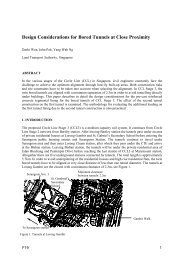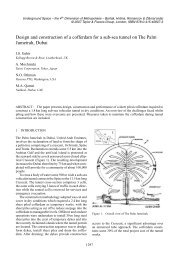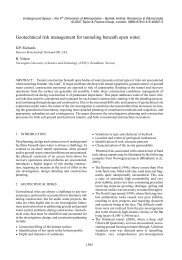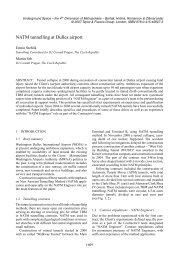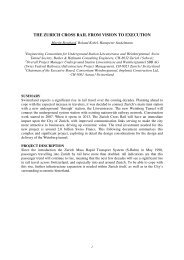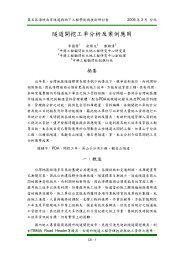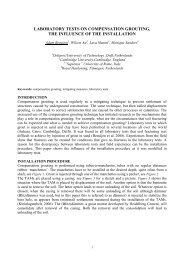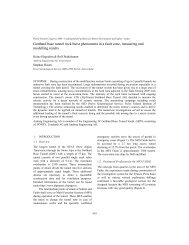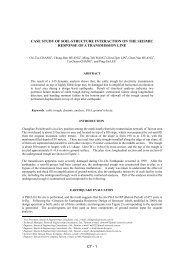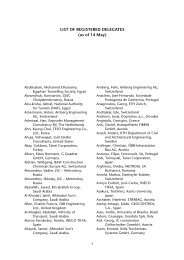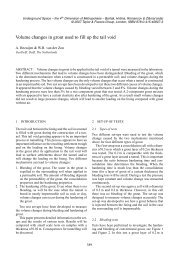Extension of RMR and Q-system in Taiwan
Extension of RMR and Q-system in Taiwan
Extension of RMR and Q-system in Taiwan
Create successful ePaper yourself
Turn your PDF publications into a flip-book with our unique Google optimized e-Paper software.
Table 3-1 Criteria for rat<strong>in</strong>g Rock Type A <strong>and</strong> B<br />
Rock mass class <strong>of</strong><br />
Rock Type A<br />
<strong>RMR</strong> range <strong>of</strong><br />
Rock Type A<br />
<strong>RMR</strong> range <strong>of</strong><br />
Rock Type B<br />
Rock mass class <strong>of</strong><br />
Rock Type B<br />
AⅠ <strong>RMR</strong>≧81 ---- ----<br />
AⅡ <strong>RMR</strong>80~61 <strong>RMR</strong>≧81 BⅡ<br />
AⅢ <strong>RMR</strong>60~41 <strong>RMR</strong>80~61 BⅢ<br />
AⅣ <strong>RMR</strong>40~21 <strong>RMR</strong>60~41 BⅣ<br />
AⅤ <strong>RMR</strong>20~11 <strong>RMR</strong>40~21 BⅤ<br />
AⅥ <strong>RMR</strong>≦10 <strong>RMR</strong>≦20 BⅥ<br />
Table 3-2 Criteria for rat<strong>in</strong>g Rock Type C <strong>and</strong> D<br />
Rock mass class<br />
Cementation<br />
St<strong>and</strong>ards <strong>of</strong> rat<strong>in</strong>g<br />
Geologic material composition<br />
Rock<br />
Type<br />
CⅠ(C)<br />
CⅠ(MIX)<br />
CⅠ(S)<br />
Fair or good cementation<br />
(can’t be dented by the thumb)<br />
The content <strong>of</strong> silt <strong>and</strong> clay is greater than 50%<br />
The content <strong>of</strong> s<strong>and</strong>, silt, clay or gravel<br />
<strong>in</strong>dividually isn’t greater than 50%<br />
The content <strong>of</strong> s<strong>and</strong> is greater than 50%<br />
C<br />
CⅡ(C)<br />
Poor or loose cementation<br />
CⅡ(MIX)<br />
(can be dented by the thumb)<br />
The content <strong>of</strong> silt <strong>and</strong> clay is greater than 50%<br />
The content <strong>of</strong> s<strong>and</strong>, silt, clay or gravel<br />
<strong>in</strong>dividually isn’t greater than 50%<br />
CⅡ(S)<br />
The content <strong>of</strong> s<strong>and</strong> is greater than 50%<br />
The content <strong>of</strong> boulders <strong>and</strong> coarse gra<strong>in</strong>s (gra<strong>in</strong><br />
DⅠ(G) Extremely good cementation size greater than sieve #4) is greater than 75 %;<br />
(boulders or gravel need to be contact with each other<br />
knocked <strong>of</strong>f by geologic hammer The content <strong>of</strong> boulders <strong>and</strong> coarse gra<strong>in</strong>s (gra<strong>in</strong><br />
DⅠ(M) with great power)<br />
size greater than sieve #4) is between 50% ~<br />
75%; don’t contact with each other<br />
The content <strong>of</strong> boulders <strong>and</strong> coarse gra<strong>in</strong>s (gra<strong>in</strong><br />
Rock<br />
Type<br />
D<br />
DⅡ(G)<br />
DⅡ(M)<br />
size greater than sieve #4) is greater than 75 %;<br />
Fair or good cementation<br />
contact with each other<br />
(boulders or gravel need to be<br />
knocked <strong>of</strong>f by geologic hammer)<br />
The content <strong>of</strong> boulders <strong>and</strong> coarse gra<strong>in</strong>s (gra<strong>in</strong><br />
size greater than sieve #4) is between 50% ~<br />
75%; don’t contact with each other<br />
The content <strong>of</strong> boulders <strong>and</strong> coarse gra<strong>in</strong>s (gra<strong>in</strong><br />
DⅢ(G)<br />
DⅢ(M)<br />
Poor or loose cementation<br />
(boulders or gravel need to be<br />
knocked <strong>of</strong>f by h<strong>and</strong>)<br />
size greater than sieve #4) is greater than 75 %;<br />
contact with each other<br />
The content <strong>of</strong> boulders <strong>and</strong> coarse gra<strong>in</strong>s (gra<strong>in</strong><br />
size greater than sieve #4) is between 50% ~<br />
75%; don’t contact with each other<br />
Notes: 1.Because the amount <strong>of</strong> water content affects the tunnel construction <strong>of</strong> Rock Type C <strong>and</strong> D<br />
considerably, this table must be adopted based on dra<strong>in</strong>age <strong>in</strong> advance.<br />
2.S<strong>and</strong> layers <strong>and</strong> gravel layers possibly appear simultaneously on the excavation face. The<br />
location <strong>of</strong> s<strong>and</strong> layers on the excavation face has a determ<strong>in</strong>ate <strong>in</strong>fluence on the stability <strong>of</strong><br />
tunnels, <strong>and</strong> it should be considered carefully while design<strong>in</strong>g tunnel supports.<br />
D7 - 6



